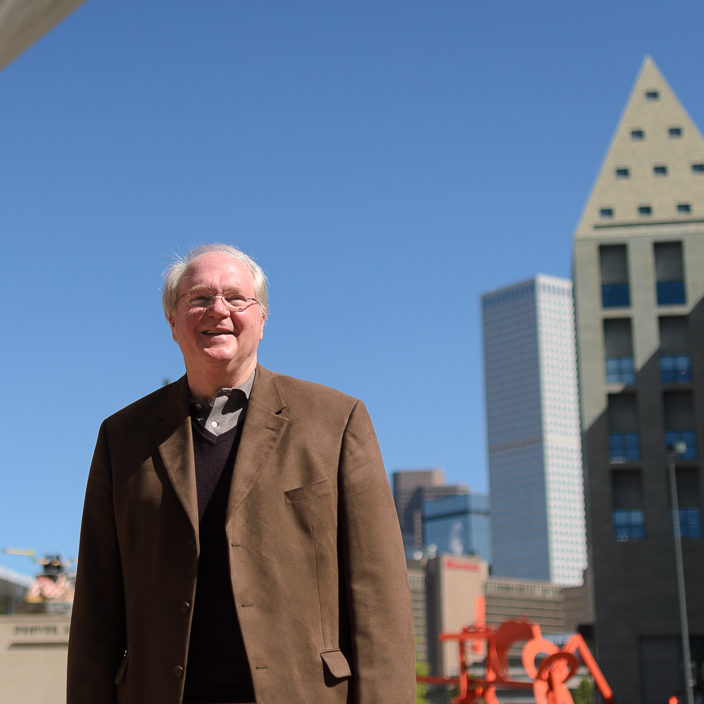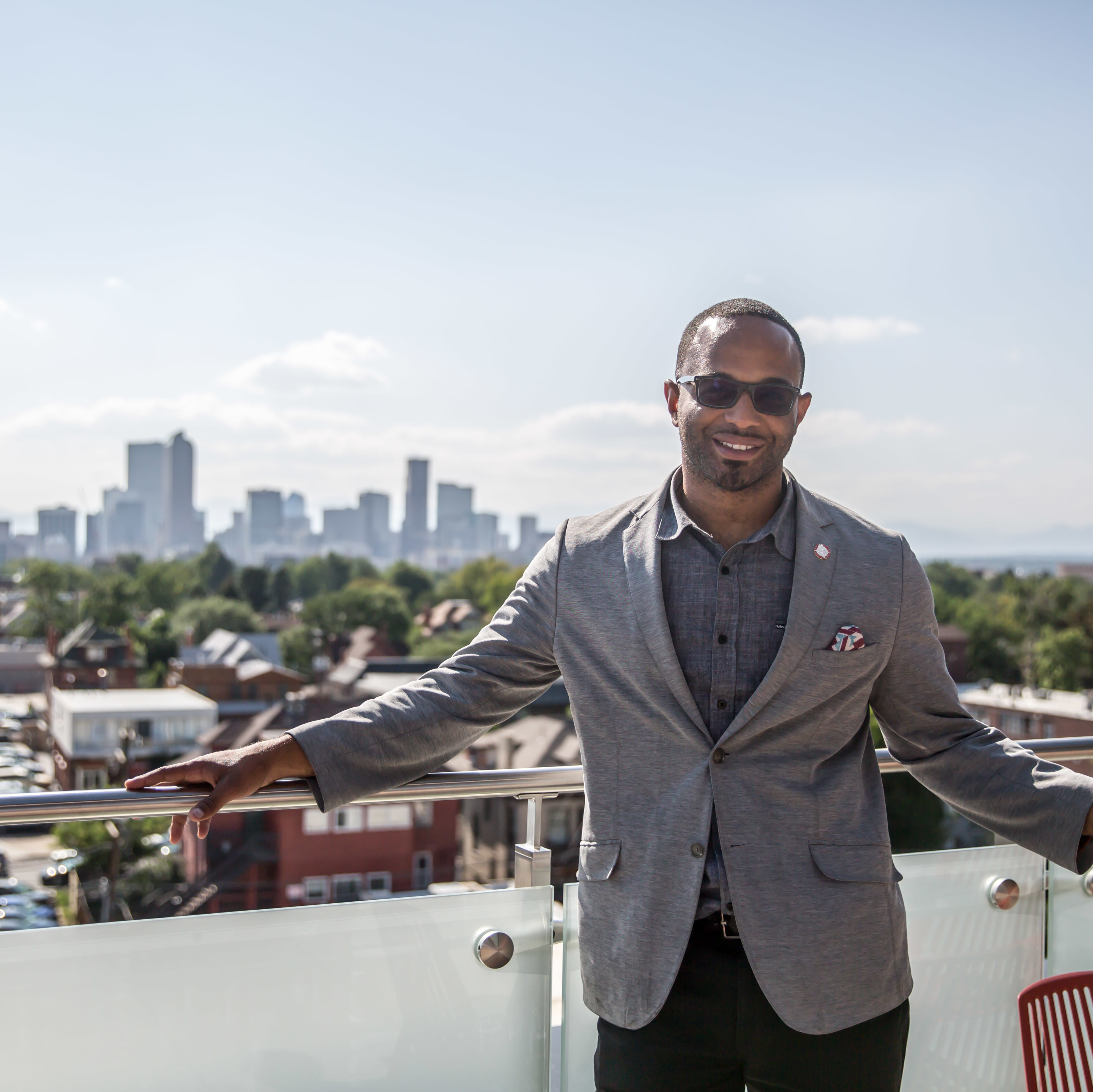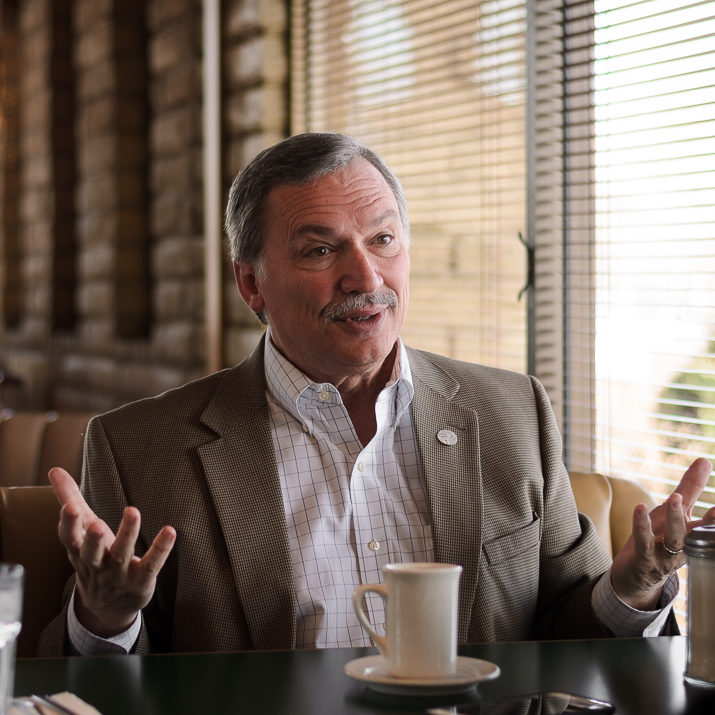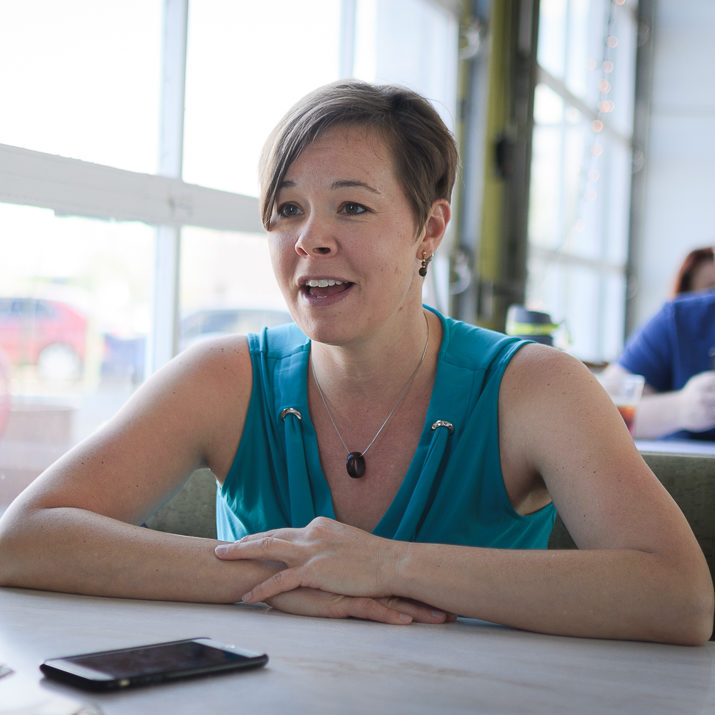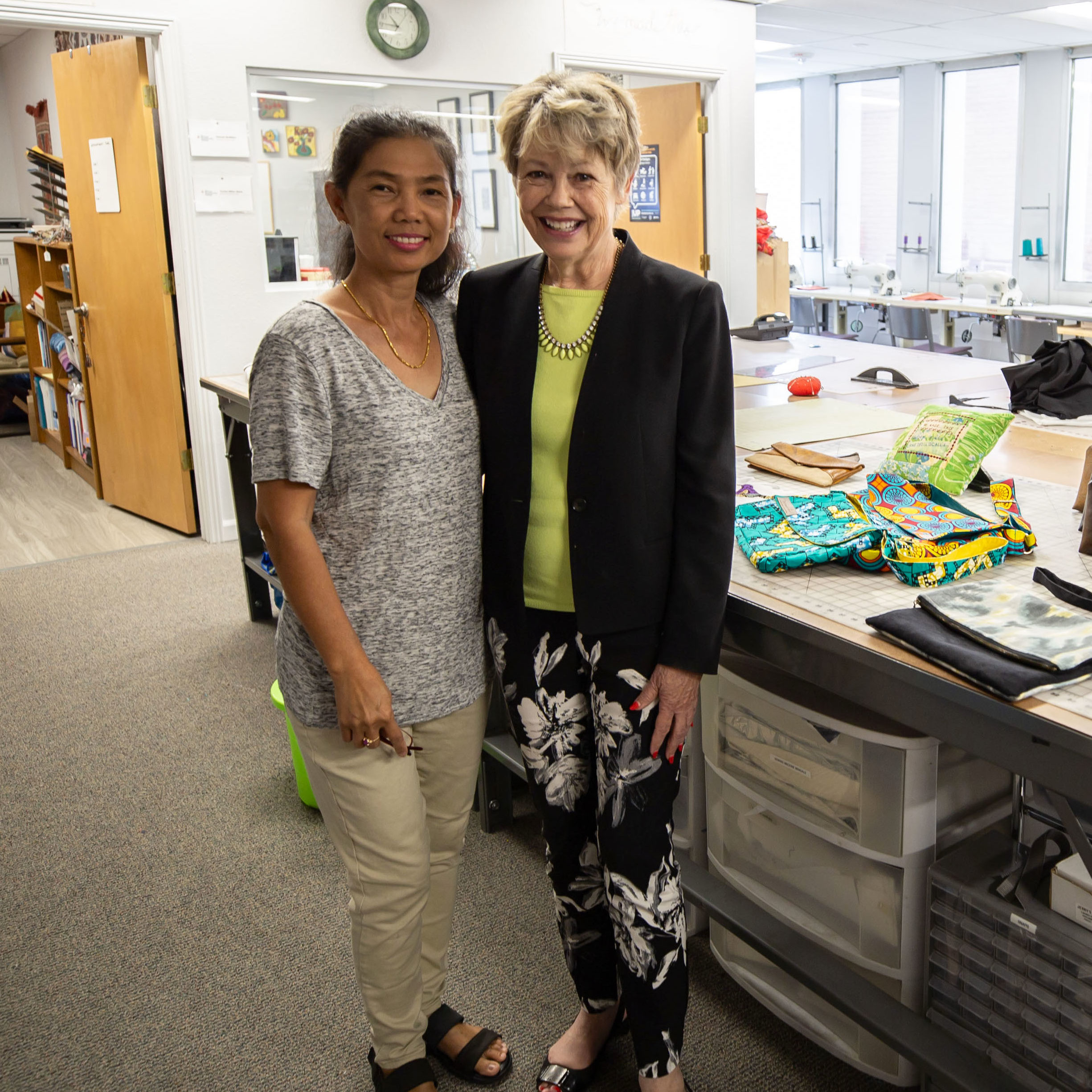If you’re new to the inner workings of local government or have binged watched one too many Parks and Rec episodes, you probably have at least one misconception about City Council. But whether you have an under or over-inflated view of the City Council race — it’s vitally important you educate your vote. Because not only does your elected leader in your district make major decisions in the city, they are in many ways your direct contact and representation for most things happening in Denver. So let’s break down the basics.
READ: A Guide to the Mayoral Candidates and Initiatives on the 2019 Denver Ballot
The Basics: Who Can Run?
The incumbents (from top left: Christopher Herndon, Wanye New, Kendra Black, Albus Brooks, Kevin Flynn, Paul Kashmann, Stacie Gilmore, Robin Kniech, Mary Beth Susman). Photography by Austin Cope, Heather Fairchild, Kyle Cooper and Giacomo Difranco.
To run for City Council you don’t need any particular educational or experience but you do need to be a US citizen, who’s at least 25 years old and has lived in Denver for two years, with one of those years being inside the district they are running for.
There are 13 city councilors with 11 from equally populated districts and another two who are elected at large (who oversee the whole city). City councilors are publicly elected every four years and usually do not run with an affiliation to a party — although in Denver they are often registered Democrats.
Their terms are four years and with a max of three terms. They are full-time city employees with a salary of $91,915 for 12 members and $102,928 for the Council President — which is elected by city councilors, not the public.
For this City Council election, there are over 40 people in the running. For any race, if no one gets a majority vote (over 50%) there will be a runoff election between the top two vote-getters on June 4.
What district do I belong to?
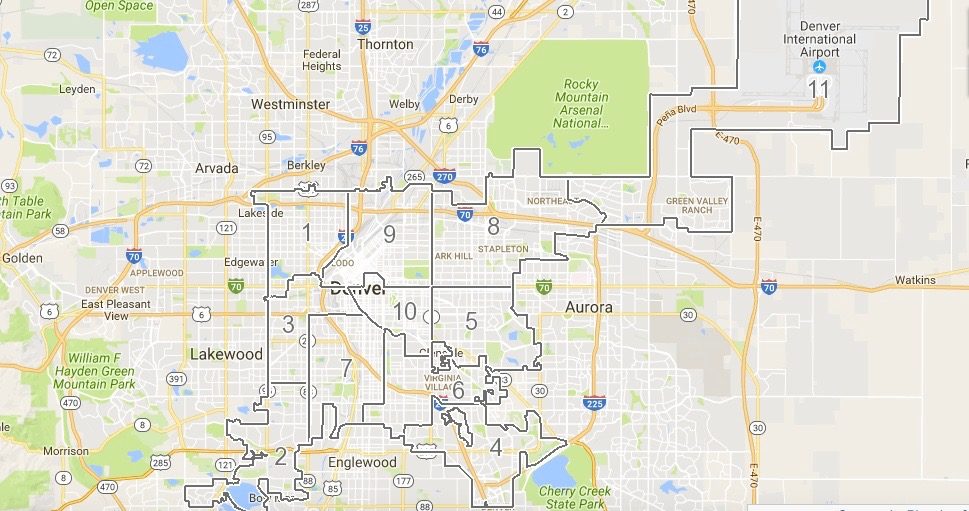
You can find your district here on this map. District maps have to be drawn at least once every 10 years according to the most recent US Census data. It was last redrawn in 2012 and became effective for the election in 2015. We’re up for a new US census in 2020, so the next map will look different.
What does the council do?
City Council has a wide purview. But mainly, they make laws, approve city contracts, create and approve budgets, determine how land is used and adopt City plans (like the freshly passed Blueprint which will guide Denver’s growth over the next 20 years). Overall, they tackle a lot — Denverite breaks it down nicely here.
They also have the power to investigate City employees and agencies. As a result, they are the counterbalance to the Mayor’s Office — essentially they are the legislative branch whereas the Mayor is the executive branch. Currently, Denver’s system has a “strong” mayor meaning that office sets the tone for the city with budgets and can make major appointments. This is one big topic for debate both in this race and the mayoral race — as some believe this is an effective, streamlined system whereas other worry it can create unethical appointments and centralized power.
City Council, in many ways, shapes how Denver will grow, change and function. If you want to keep track of what they are doing you can attend and speak at their Monday meetings and track legislation here.
Note: You only vote for the councilors in your district and the At-Large nominees. So no need to read the entire guide (unless, you want to).
At Large
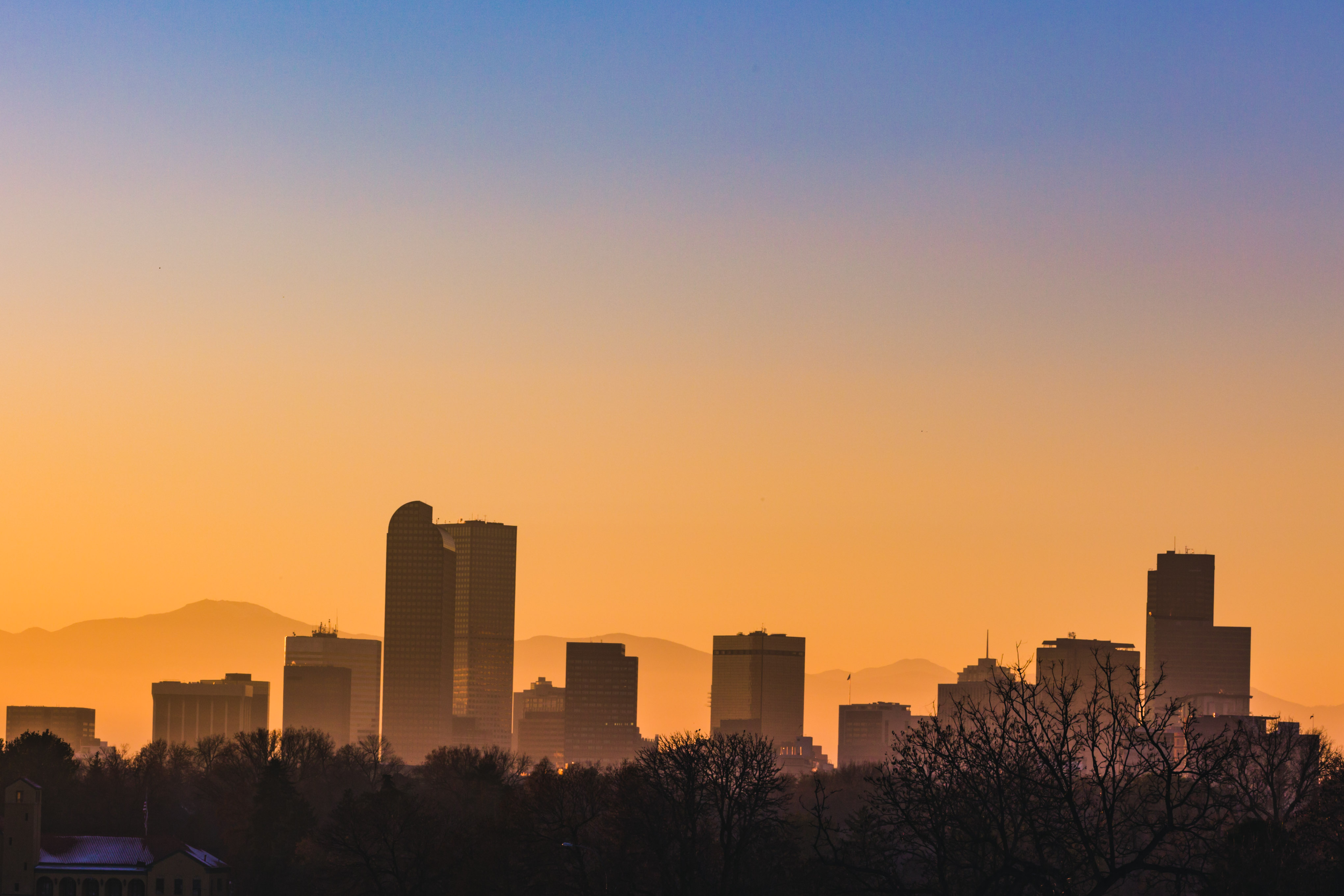
Where: All 11 Districts in Denver, from the airport in the East to Sheridan Boulevard on the West. See the map here.
Defining Aspects: Denver, as a whole, has grown explosively during the last four years. With that growth, we’ve gained more jobs and money, but we’ve also started to push out long-time residents from their homes and neglect the growing homeless population. The at-large representatives can have significant influence over the decisions that change the direction of our city’s policies, partnerships and ordinances.
District Issues: The issues in the District-At-Large are the same for the Mayoral race — concern over the unchecked growth of the city that affects the housing and job markets, a desire to improve the public transportation system and a push toward more aggressive sustainability goals. Many of the candidates for the two at-large positions are also speaking out about inclusivity in politics as well as in other city services, focusing on immigrant, LGBTQ+ and non-white equity.
Also read: Denver Post’s Q&A, Denverite’s breakdown
Who’s running
Incumbents: Robin Kniech and Debbie Ortega
Robin Kniech – read our profile about her here.
For: Empowering women, environmental standards, immigrant and LGBTQ+ rights, equity in housing and jobs.
Against: Unbridled development (she was the first to sponsor a fee for development during her last term), focusing on high-paying tech-industry jobs instead of middle class jobs, lack of free access to compost and recycle services in all neighborhoods
For: Prioritizing existing city services before adding more, advancing sustainability initiatives, socio-economic diversity in housing, protecting neighborhoods from violence
Against: “Rubber stamping” of issues (meaning she won’t vote on something just because everyone else who is superior to her does), poor public transportation/ infrastructure and the affordable housing crisis.
For: Advocating for children and the deaf community, supporting the arts (he is an artist, writer and musician himself), renter’s rights and remembering Denver’s rich history.
Against: Stale decision-making in politics, the lack of representation for creatives, limited accessibility in cities for deaf populations and development with gentrification.
For: Supporting African-American owned businesses in Denver, attainable housing, relief from food deserts and inclusivity for all sexual orientations, races and genders.
Against: Urban camping ban, discrimination, elitism in politics
For: Livable wages and paid family leave, affordable housing that includes rentals as well as first-time homeowners, civil rights especially when it comes to being Latinx or African-American in Denver and a Green New Deal for climate change.
Against: Overcrowding and underfunding of public schools, lack of equality for everything from professional sports teams to jobs, growth without community involvement.
For: It is unclear what exactly Langdon stands for since she doesn’t have her stances posted on her website. But, from an interview with Denverite, Langdon reportedly supports “amplifying RTD’s advertising budget” to help persuade more people to use public transportation. Also, Langdon is in favor of the camping ban. A video from Denver Decides might help with some of her other views.
Against: Langdon reported she does not approve of supervised use sites, and she doesn’t support homeless individuals sleeping in public areas. In her Q&A with the Post, she explains she is against fracking.
District 1

Where: Chaffee Park, Regis, Berkeley, Sunnyside, West Highland, Highland, Sloan Lake, Jefferson Park, West Colfax (see district map here).
Defining Aspects of the District: Traditionally considered the North Side of Denver, District 1 is filled with historic residential neighborhoods and the frequently-used Sloan Lake park. With the Tennyson Creative District and West 32nd Avenue, this area is pushing for local businesses and pedestrian traffic.
District Issues: Residents in District 1 are most concerned with unbridled development and the decreasing availability of affordable housing for the middle class. As a historically residential-centric area, the main issues revolve around quality of living, and aside from affordable housing, this includes general public safety as well as ease of transportation. Most candidates are zeroed in on improving and increasing the few public transportation options currently available within District 1 and between the district and the rest of the city.
Also read: How West Colfax Will Change in the Next 5 Years, Denver Post’s Q&A
Incumbent: Rafael Espinoza is no longer running for this City Council seat. But, if you’d like to know more information about him during his term in District 1, read our profile on him here.
Who’s running
For: Affordable housing, mental and behavioral health services and protecting the history of the North Side.
Against: Rapid development and working without community input.
For: Improving transit and mobility while focusing on environmental standards, affordability in renting and owning homes, a strong local economy with jobs and safer communities.
Against: Unchecked growth with little foresight (like not including parking spaces for new developments)
For: Cannabis — both in reaping the benefits of marijuana taxes as well as educating others about the medical and recreational effects. Also focused on small business owners (as a small business owner himself) and the lack of public transportation which connects the different neighborhoods in the district.
Against: Lack of communication between neighborhoods and districts, vehicular travel as primary transportation
For: Champions the idea of a working middle class who can afford their neighborhood
Against: Focusing too much on tech-industry related jobs and building new developments instead of repurposing unused “big box” stores.
For: Renter’s rights, transportation solutions and affordable housing. He’s strongly in favor of Accessory Dwelling Units, or secondary structures constructed on private property that can be sublet or rented, allowing homeowners an additional revenue source.
Against: Developers building expensive high-rises and the lack of understanding or enforcement of renter’s rights.
For: Smart development which includes limits on security deposits for renters, apprenticeship positions at construction sites and speed limit reductions in residential neighborhoods. Sandoval also has more specific ideas around environmental sustainability, including more trash and recycle receptacles at public parks and a few capital improvement projects.
Against: Disappearance of green space to developers, unbridled zoning laws and the increased crime rate in District 1.
For: A better sense of community and safety in North Denver, affordable housing and better public transportation — the last one pivots on the idea that we should adopt electric streetcars in order to have fast results while we wait for major transportation infrastructure improvements.
Against: The status quo approach to homelessness, transit plans that “sound good on paper” but don’t have tangible results and the lack of community that has come with expansion.
District 2
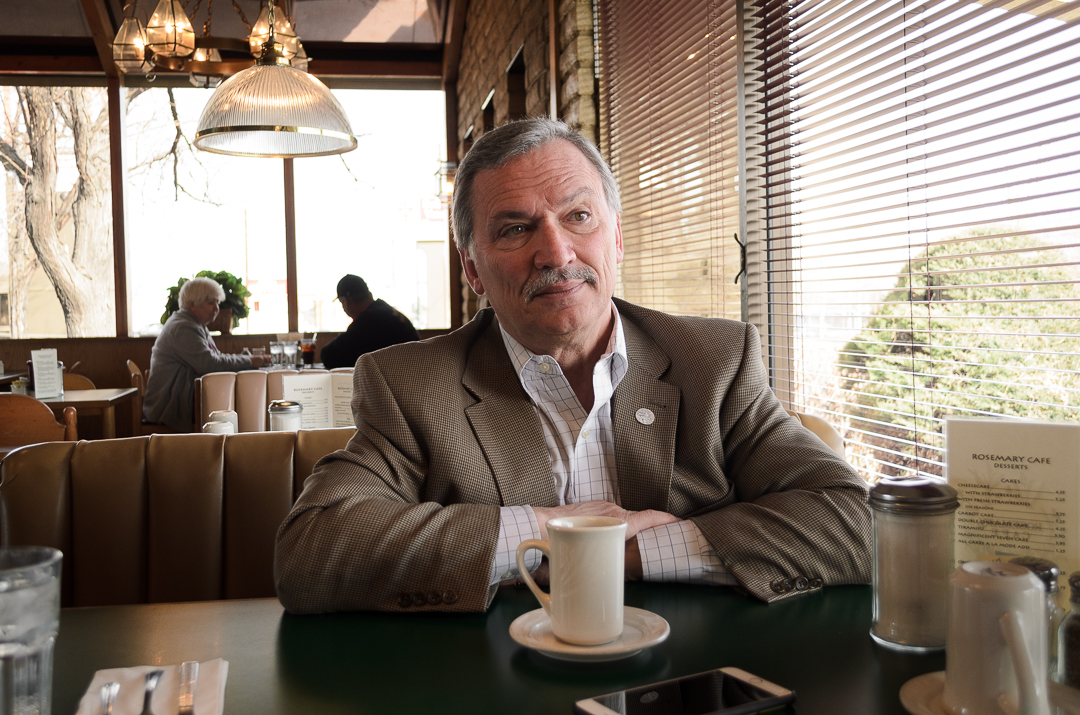
Where: Marston, Fort Logan, Harvey Park, Harvey Park South, Bear Valley (see district map here).
Defining Aspects of the District: Mostly composed of suburban real estate, District 2 has been on a slightly different page from the rest of Denver since the 1950s. The average age for most of the neighborhoods is over 50, and the main defining characteristics are the lakes and green spaces that pepper the area. District 2 also includes the Fort Logan National Cemetery, which is on the National Register of Historic Places.
District Issues: Although District 2 doesn’t face the same issues in regard to gentrification and development as other Denver districts, the incumbent Kevin Flynn has made a point to work hard on budget oversight and transparency with the city as a whole. As a district with an older population, District 2 is usually concerned about affordable living (especially when the citizens are on a fixed income) and keeping the house or land that their families have probably owned for generations. Residents often speak about the importance of their parks and green spaces, and that relates to the protection of those spaces from development, pollution and climate change.
Incumbent: Kevin Flynn. He is the only candidate running for District 2. Read our profile on him here.
District 3

Where: Villa Park, Sun Valley, Lincoln Park, Barnum, Barnum West, Westwood, Mar Lee (see district map here).
Defining Aspects of the District: District 3 encompasses some of the lowest-income neighborhoods in Denver. But, the proximity to Downtown, as well as the inclusion of the Mile High Stadium makes this area seductive to developers. Historically District 3 has been comprised of immigrants. First it was mostly Jewish — but Irish, Italian and Latino families have made it home ever since. It is also home to the Art District on Santa Fe, the Westwood/Morrison Road Cultural District and the Little Saigon Business District.
District Issues: The location of District 3’s neighborhoods — just across I-25 from Downtown — make unfettered development and gentrification a major concern for everyone who already calls it home. Meow Wolf’s new 90,000 square-foot art exhibition is currently under construction in the Sun Valley neighborhood and the Broncos’ stadium plans to build housing and retail in one of the parking lots, causing some to worry about the preservation of District 3’s rich culture. Rising living costs have been problematic, as well as lack of access to green space, public transportation and pedestrian safety.
Also read: How Sun Valley Will Change in the Next Five Years, How Meow Wolf Plans to Support Denver’s Community and Combat Gentrification, Denver Post Q&A
Incumbent: Paul Lopez. He is not running for City Council because he has reached is term limit, although he is running for Clerk & Recorder. For more information about him, read our profile on him here.
Who’s running
For: Reviving the Revolving Loan Fund for small businesses, standing for civil rights, equalizing the ratio of wages to rent and taking a proactive approach to climate change (saying that “everyone deserves a healthy neighborhood to grow up in.”)
Against: Displacement of existing community members because of rising home prices (both renting and owning), declining air and water quality due to avoidable pollution and civil rights abuses (she opposes the urban camping ban).
For: Access to low-income housing, growth within the community in the sense of more access to parks and grocery stores (much of District 3 is considered a food desert) and support for seniors and the elderly.
Against: The “school to prison pipeline,” curbing gentrification but not growth and the urban camping ban — she has called it unconstitutional.
For: Infrastructure improvements including fixing the sidewalks, streets and bridges that connect West Denver, higher wages on typically lower-earning or minimum wage jobs, bettering the police-to-community relations and inclusivity to all genders, races and backgrounds.
Against: Homeless sweeps or temporary solutions to the permanent problem of homelessness, development with displacement and a lack of recreational, educational and other opportunities for the local youth.
For: Educating local community members about the resources that already exist to help with development concerns, fostering a strong immigrant population, ensuring safety for pedestrians and supporting local artists.
Against: Intolerant safety officials (like police officers), lack of budget for multi-modal transportation, exclusive laws or regulations that isolate immigrants and certain predatory practices of developers.
District 4
Where: University Hills, Hampden, Hampden South, Wellshire, Southmoor Park, Kennedy, Goldsmith (see district map here)
Defining Aspects of the District: District Four is a mix of residential homes and large swaths of big box stores and strip malls. Despite having the second most light rail stops, it is defined by car culture, highways and busy thoroughfares.
District Issues: District 4 is the land of strip malls and parking lots in Denver. It’s also defined and dissected by major streets and highways like I-25 and Hampden Avenue. As a result, the people in District 4 want to make it more walkable by improving sidewalks, adding bike lanes and making crosswalks safer. Additionally, District 4 wants to bring in more local retail and restaurants to counterbalance the big box stores and chain restaurants that dominate the area. There is also a debate on parking lots. The incumbent Kendra Black wants to reduce the amount of available parking to counteract the current car-culture and bring in better planned developed like Glendale’s CityScape, but developers and some residents are reluctant.
Also read: Denverite’s profiles, Denver Post’s Q&A
Who’s running
Incumbent: Kendra Black (Read our full profile here)
For: Increased local retail and restaurants, smart, planned and innovative development that increases community and walkability while maintaining character, improved sidewalks and crosswalks for pedestrian safety and protecting while creating more green spaces with a focus on the Highline Canal and a new park in University Hill.
Against: Car culture, big parking lots, more big boxes stores and cookie-cutter development, Initiative 300
For: Affordable housing, improved infrastructure for roads, sidewalks and bike lanes, increased walkability and pedestrian safety, multi-modal transit, increasing city employee wages for working families, transparency in local government and combating climate change
Against: Corruption in local government and low transparency for elected officials, inefficient spending, abusive and predatory leasing practices for renters and seniors.
District 5
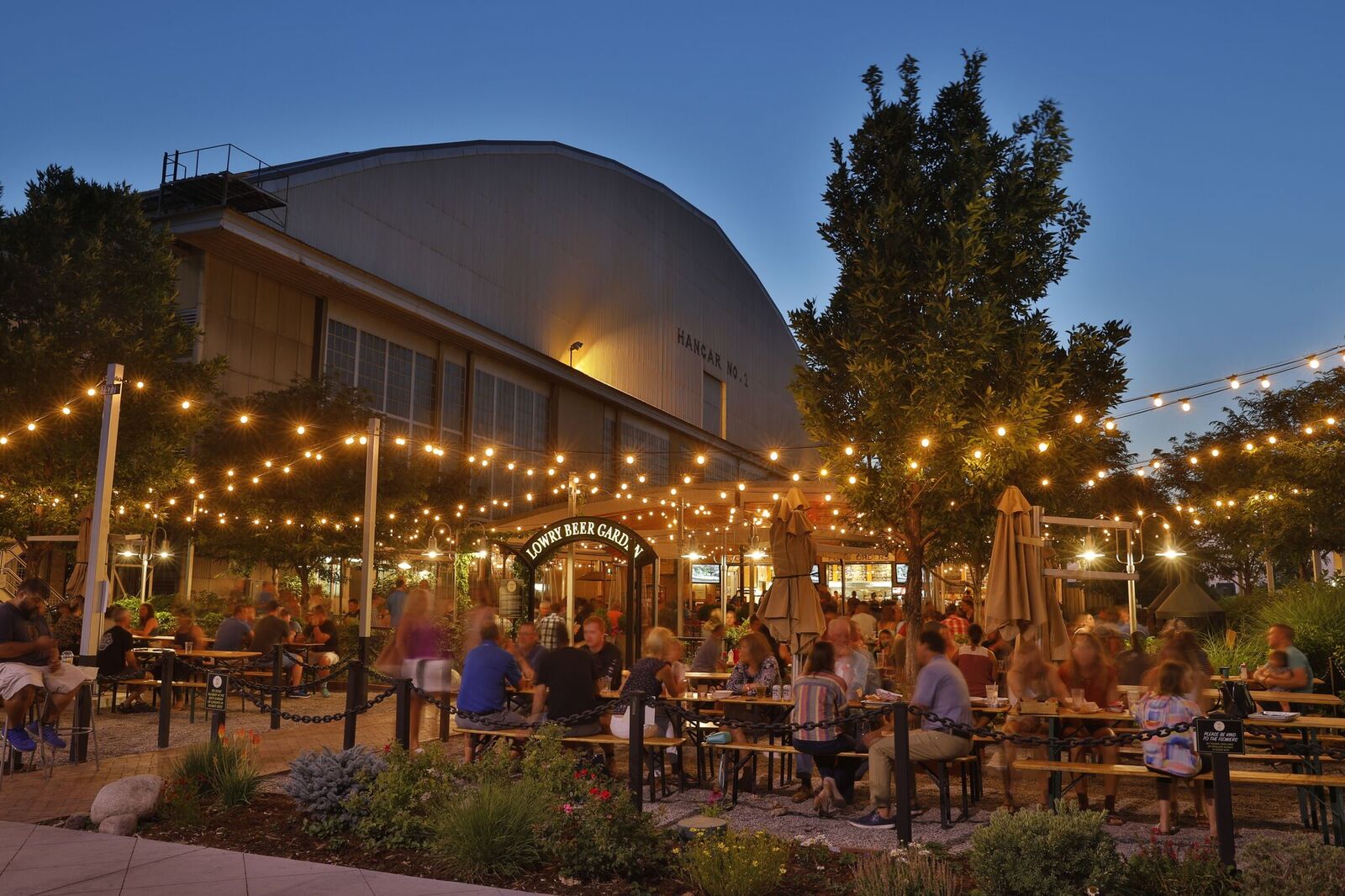
Where: Monclair, East Colfax, Hale, Lowry Field, Hilltop, Windsor, Washington Virginia Vale (see district map here)
Defining Aspects of the District: District 5 is home the Montclair Recreation Center and the Schlessman Library; as well as two fire stations, two hospitals, 12 schools, 22 parks and the Highline Canal. The Wings Over the Rockies Air and Space Museum lies within this district as well as Colorado Free University and a charming Town Center with Denver’s first beer garden. The average demographic of homeowners within this district is still pretty affluent, with the average income being around $60,000 and the overall majority of citizens being white (about 73%.) East Colfax defines its northern border making it a dense district with an eclectic set of issues. East Colfax has been a historically relevant part of Denver — and national — history.
District Issues: Because of its density, District 5 main issue has been cited to be traffic control and overall transportation mobility, specifically on East Colfax. Over 22,000 individuals use the bus system on East Colfax and it has been heavily criticized. Rerouting and revamping the public transportation system is a priority for this district. Gentrification and affordable housing are still big markers of the area, with neighborhoods increasing in value and pushing out many residents. East Colfax is a historic part of Denver and therefore the upkeep of East Colfax is an important issue that runs through several districts including five. The main takeaway for East Colfax is the desire to keep its original aesthetic — often referred to as “gritty” — while still increasing development and making it a safer area of Denver to visit.
Also Read: How East Colfax Will Change in the Next 5 Years, Denver Post’s Q&A, 5280’s District Guide
Who’s running
Incumbent: Mary Beth Susman (Read our full profile here)
For: Restructuring public transit (micro transit, separate mobility department), the upkeep and safety of East Colfax, economic development, urbanism, affordable housing, Urban Camping Ban
Against: Rezoning (unless for developmental purposes), Involuntary displacement
For: Transparent and accountable government (specifically for development funded by tax-payer money), campaign finance reform, Source of Income Anti-Discrimination Ordinance, affordable housing, minimum wage increase
Against: Tax Incremental Financing and other incentives given to corporation and developers, urban camping ban
For: Slowing new development (he told the Post he wants a two-year moratorium on new building permits), working with RTD to use smaller buses during non-peak hours while reducing fares and affordable housing
Against: New development (especially small studios in high rises), higher minimum wage, Initiative 300
For: Restructuring development to be more community focused, increased funding and allocation to police precincts in order to diminish crime, reallocate public transit funding to deal with the traffic congestion issue, environmental incentives, housing the homeless population appropriately, higher minimum wage
Against: Fracking, zoning that doesn’t account for parking or traffic, city contracts that don’t benefit Denver workers
District 6
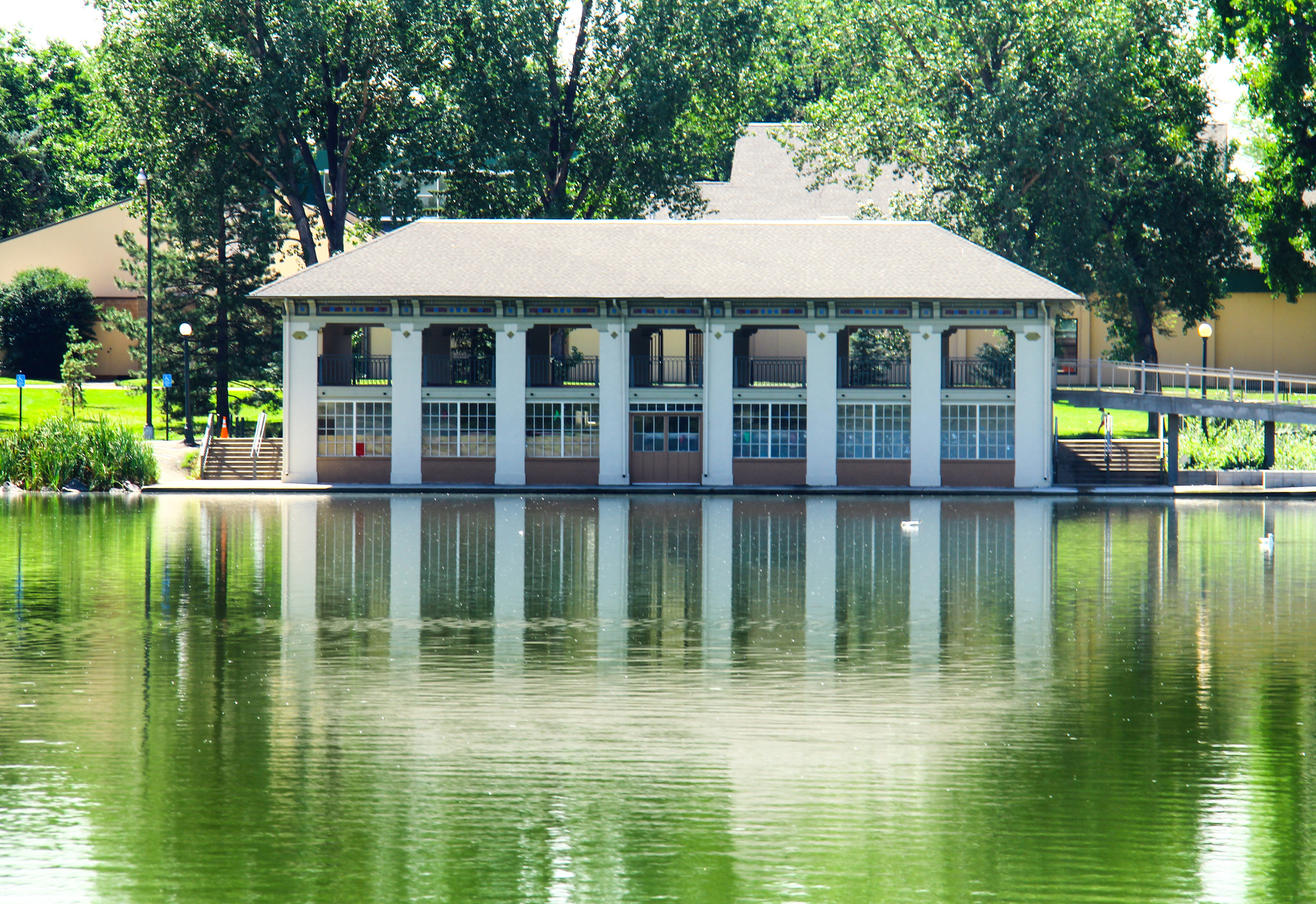
Where: Washington Park, University, University Park, Rosedale, Cory-Merril, Belcaro, Virginia Village, Indian Creek (see district map here)
Defining Aspects of the District: One of the wealthiest neighborhoods in Denver, District 6 is defined by its sweeping landscape of parks and pleasing brick-style houses. District six is also home to Washington Park, Virginia Village and University of Denver. District six is predominantly white, with 87% of its residents being white and in the higher income brackets of the city as a whole. Because of it also including the University of Denver, District 6 is collegial in population as well.
District Issues: Because of its affluence, District 6 has different issues than most. The population density around Colorado Boulevard has definitely raised developmental concerns, bringing with it the possibility for more homelessness. With that in mind, the district has tried to create preventative measures for the overcrowding.
Incumbent: Paul Kashmann he is the only candidate running for District six (Read our full profile here)
For: As explained to the Post, he wants to create a separate Department of Mobility to help transportation and the environment, increasing funds and resources for Denver’s police, sheriff and fire departments, expediting Denver’s Road Home three-year plan to restructure shelters to tackle homelessness, higher minimum wage and preserving historic districts
Against: Accepting campaign donations from special interest groups or PACS, slow permitting, licensing, inspection and project review services for small businesses
Also Watch: Paul Kashmann’s Official Policy Video, Denver Post Q&A
District 7

Where: Baker, Speer, Valverde, Athmar Park, Washington Park West, Ruby Hill, Platt Park, Overland, College View – South Platte (see district map here)
Defining Aspects of the District: District 7 is an urban-meets-suburban sprawl, with the Baker district and its commercial influence paralleling Washington Park West and Ruby Hill’s suburban concentration. District 7 was the home of Grandoozy, the new music festival of 2018 backed by Superfly meant to bring more prosperity to the district. Due to its demographic and geographic variety, District 7 has several different key issues that need to be addressed.
District Issues: With such an extensive plane of influence, District 7 has a lot of priorities. As with most districts experiencing a population increase, District 7 is prioritizing transportation and mobility, homelessness and housing, overall public safety as well as focusing on sustainability and the environment. There are specific neighborhoods within this district that are not equipped for public-transit — like Athmar Park having very few bus lines and poorly paved sidewalks for a walking commute to the nearest Light Rail.
Incumbent: Jolon Clark is the only candidate running for District 7. He has served as City Council President since 2018. You can learn more about his policies here.
For: Enhancing Parks & Recreation, improving transportation and mobility by restructuring RTD, adding bike lanes and improving sidewalks and overall infrastructure of roads and underpasses. Focusing on incentivizing better mental health and shelter for the homeless, increasing police force in order to create safer neighborhoods
Against: Involuntary displacement created by lack of equity in neighborhoods
Also Watch: Jolon Clark’s Forum,
District 8
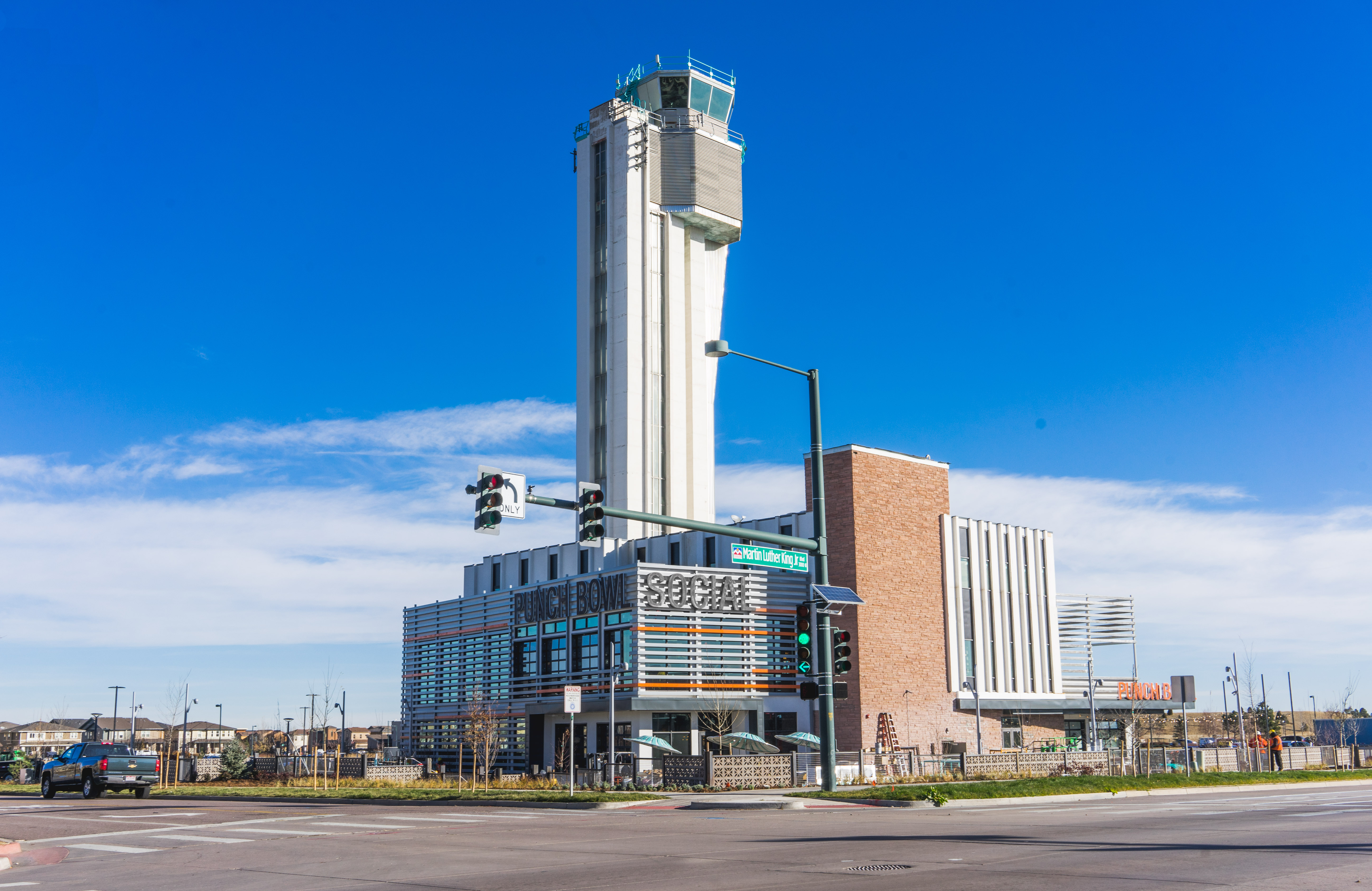
Where: Stapleton, Montbello, East Colfax, North Park Hill, Northeast Park Hill, South Park Hill (see full district map here).
Defining Aspects of the District: District 8 is an economically and racially diverse area. It combines high-income neighborhoods of Stapleton and North and South Park Hill — making it one of the most affluent areas in the city — with lower income communities of Montbello, East Colfax and Northeast Park Hill. Household incomes range from as low as $37,000 to as high as $123,000. It’s mainly residential with bigger developments taking place largely in Stapleton.
District Issues: District 8 has a set of issues that are as wide-ranging as its citizens. In Stapleton, they are concerned about rapid development whereas East Colfax is in need of revitalization. North and South Park Hill worry about neighborhood speeding and infrastructure whereas Montbello is mostly concerned about affordable housing, homelessness and impacts of poverty. Overall, each section has a unique set of needs. But the district does have a shared goal of improving mobility and public transportation in the area. They seek to improve sidewalks, pedestrian safety to make the area more walkable and accessible for all of its residents. Affordable housing is also on their agenda as well as creating more jobs for low-income individuals through “workforce development, targeted hire and job training programs.”
Also read: How East Colfax Will Change in the Next 5 Years, Denver Post Q&A
Who’s running
Incumbent: Christopher Herndon. Read our profile here.
For: Youth empowerment and engagement through leadership programs, public safety through increased but responsible policing, affordable housing, senior housing and shelters for the homeless and community building through events.
Against: A police force not connected with the community, ending the current camping ban, decentralizing the power of the Mayor’s Office, and an “us vs. them” mentality when it comes to development and Denver’s growth.
For: Affordable housing through linkage fees, rent control and increased down payment assistance programs, supporting the working class through increased minimum wage and the support of bargaining rights of unions, improved access to health care via free shuttles, new clinics and urgent cares and environmental policies by creating a Green New Deal for Denver.
Against: Fracking, urban camping ban, Olympics, Central I-70 Project
For: As explained to the Post, she favors slowing down growth in Denver, delaying the approval of Denver’s Blueprint plan until after the election for City Council, increasing the minimum wage, more affordable housing and focused action on ending homelessness
Against: Gentrification, new development (wants a six to eight-month moratorium) and the current camping ban
For: Affordable housing through a mix of housing options, improved transportation through improved infrastructure, higher minimum wage, more green spaces, more local retail options, investment in entrepreneurship, youth development programs and skill building and employment programs.
Against: Restricting development in single-family neighborhoods, the current camping ban, maintaining the status quo of centralized power in the Mayor’s Office.
For: More parks and open spaces and the increased protections of them, alternative transportation like solar-powered streetcars, electric trolleys and more express buses, more affordable housing via increased linkage fees and increased power of communities when it comes to development (specifically through Registered Neighborhood Organization and forum based zoning code), higher minimum wage for city employees
Against: Initiative 300 and maintaining the status quo of centralized power in the Mayor’s Office
For: Increased affordable housing and better tracking of affordable housing units, a more robust transportation network, community inclusive development, improved care of senior citizens through improved sidewalks and more community healthcare options.
Against: Maintaining the status quo of centralized power in the Mayor’s Office, poorly planned development
District 9
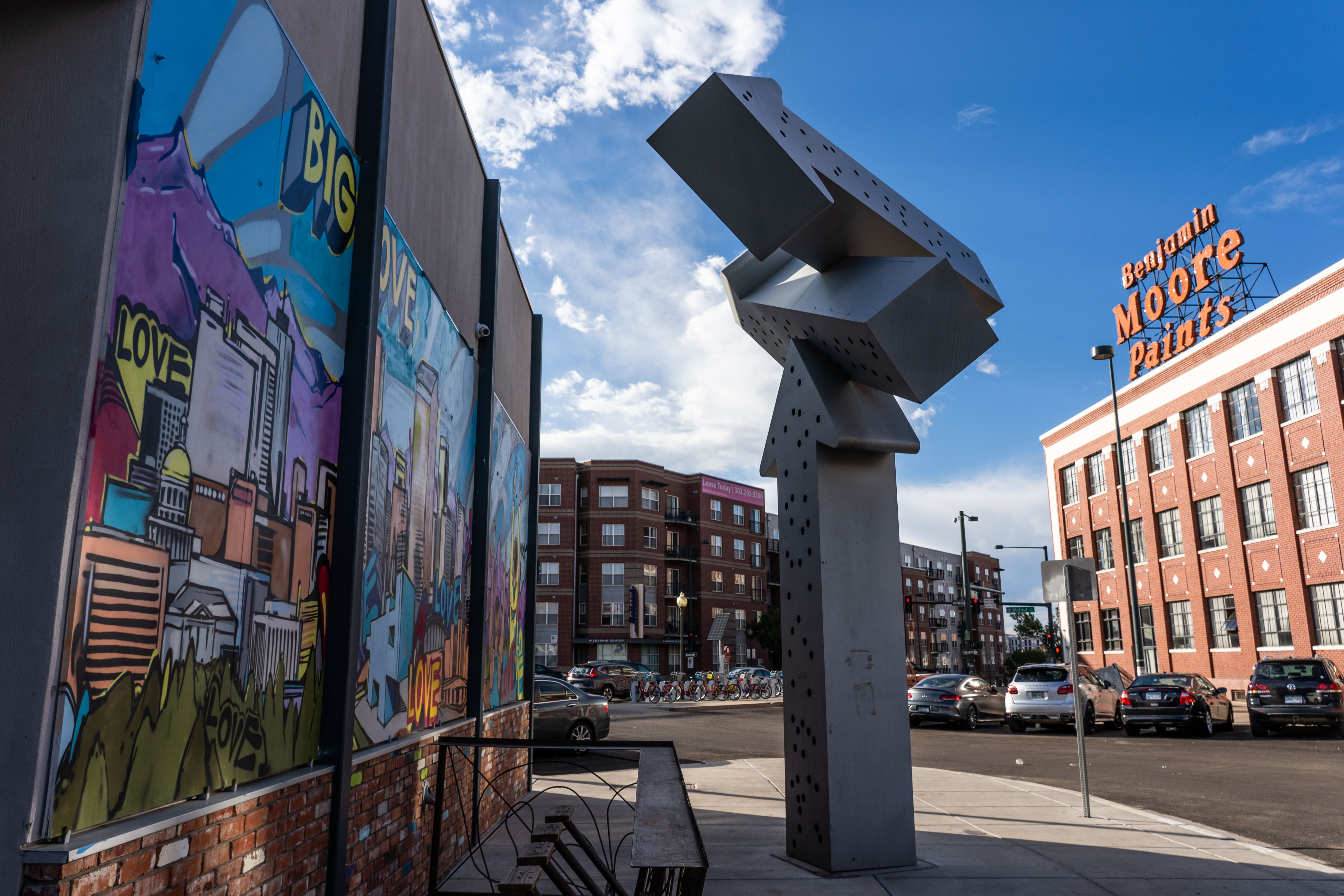
Where: Globeville, Elyria-Swansea, Five Points (includes RiNo), Cole, Whittier, Clayton, Skyland, City Park, City Park West, LoDo, Union Station, Auraria, Central Business District (CBD) (see full district map here).
Defining Aspects of the District: District 9 is massive. It encompasses everything from historic residential neighborhoods such as Whittier and Globeville to important cultural institutions like the Denver Zoo, Denver Museum of Nature and Science, Auraria Campus and the DCPA as well as important attractions like Union Station, City Park, Coors Field, Pepsi Center, Elitch Gardens, National Western Stock Show Complex and more. It is a hub of nightlife and culture as LoDo, RiNo and Five Points all lie within its boundaries. District 9 is also as diverse in its population as it is in its physical landscape.
District Issues: Since District 9 covers such a large swath of the heart of Denver, it also has a majority of the city’s issues. Like many other districts — affordable housing, how to combat homelessness and transportation all rank high. But because it encompasses so many different walks of life (and commerce), there’s large disagreement on how to combat those issues. Divisive projects like Central I-70 project and its impacts on City Park are a prime example of how heated a debate can get. Additionally, their outcome can also have a large impact on the city at large and the many places within the district that people tend to enjoy. For example, District 9 is home to many of the city’s homeless service providers, major transportation hubs like Union Station and large amount of Light Rail and RTD stops. So decisions on homelessness and transportation will weigh heavy in this area. For the residential side, the gentrification issue looms incredibly large. As the home to the city’s fastest growing area, RiNo, and the city’s most historic neighborhoods — debate on development and housing is paramount.
Also read: How RiNo Will Change in the Next Five Years, Denver Post’s Q&A,
Who’s running
Incumbent: Albus Brooks. Read our full profile here
For: Improved youth initiatives specifically by creating full-time cabinet-level position for My Brother’s Keeper program and youth workforce training programs, more affordable housing by creating a “Land Bank” through city-owned land where affordable housing can be built, improved transportation by completing funding for the Denver Moves plan, combating homelessness through employment via Denver Day Works and long-term housing solutions. Additionally, he supports Supervised Injection Sites to combat the opioid epidemic
Against: Ending the current camping ban, decentralizing the power of the Mayor’s Office and restricting development
For: Responsible growth by implementing tools that empower the community — i.e. Renter’s Bill of Rights and Community Bill of Rights for new developments, creating community-led land trusts, making co-ops and other community-based living options legal by revising zoning and occupancy codes (etc). Using innovation and private partnerships to modernize and connect the city’s transportation gaps without heavily relying on RTD. Making local government more efficient and transparent by streamlining agencies, using updated technology to increase local participation and creating accountability systems like a city council vote tracker and scorecards.
Against: Current camping ban, maintaining the status quo of centralized power in the Mayor’s Office, more luxury developments, allowing elected officials to accept gifts, trips and benefits and sale of city-owned land for market-rate development
For: As told to the Post, he supports first responders, oversight in the Mayor’s office, assistant for seniors and veterans, equality in neighborhoods across District 9 and a safer, cleaner and healthier district
Against: Higher minimum wage, ending the current camping ban, polluting waterways
For: Increasing the minimum wage, more affordable and equitable housing through income-restricted housing, renter and ownership control, zoning reform and increased linkage fees and more checks and balances in local government
Against: Supervised injection sites, maintaining the status quo of centralized power in the Mayor’s Office, corporate or special interest money in campaign donations
District 10
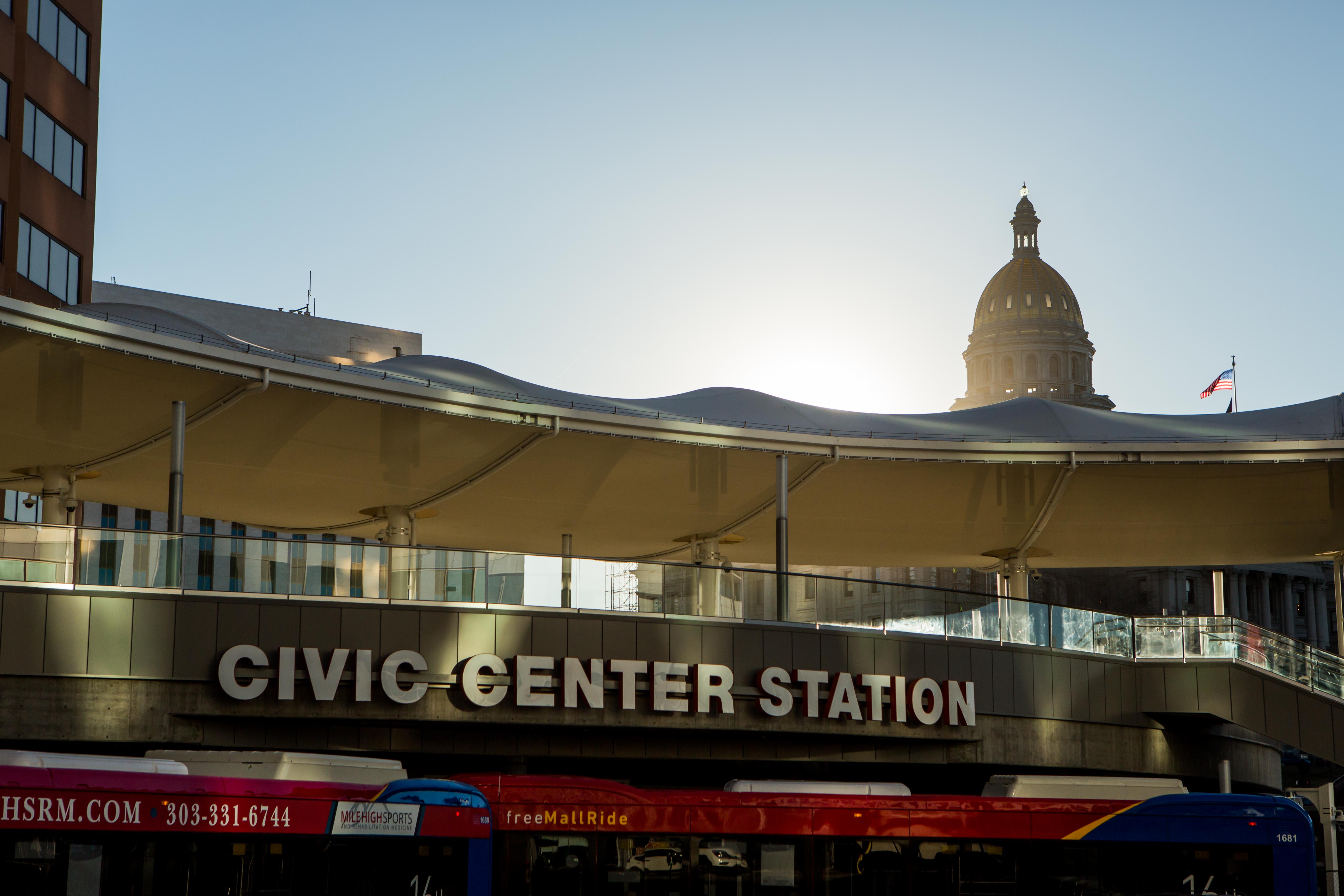
Where: North Capitol Hill, Capitol Hill, Civic Center, Cheesman Park, Congress Park, Cherry Creek, Country Club (see district map here)
Defining Aspects of the District: District 10 is home to the Golden Triangle, with most of the museums in the city being a key aspect of the district. District 10 also has some of the most famous spots around Denver, with the Capitol Building, Civic Center Park, Cheesman Park, The Botanic Gardens, Cherry Creek, Congress Park and important parts of East Colfax. In terms of residential areas, District 10 is home to both Capitol Hill, a destination for transplants, creatives and young professionals alike, as well as Cherry Creek, one of the most affluent neighborhoods in Denver.
District Issues: District 10 is home to Civic Center Park, one of the most popular areas for the homeless around Denver. Because of this, homelessness and affordable housing are at the forefront of priorities for this district. On the other side of the spectrum, District 10 also prioritizes upkeep and funding of the arts, with the Denver Art Museum, the Denver Public Library and several other staple locations for the arts being a part of the district. Because of its inclusion of the Civic Center Station, a relatively new hub for public transportation, transportation as a whole is also an important issue within this district. As a large outdoor venue for events like the 4/20 celebration, political rallies and Pride, residents have also raised concerns regarding trash and congestion around Civic Center Park.
Also Read: Denver Post’s Q&A, How East Colfax Will Change In The Next 5 Years, Vandals Deface Tree of Transformation in Civic Center Park
Who’s running
Incumbent: Wayne New (read our full profile here)
For: Re-zoning based on transparency with the intent to represent the residents of each neighborhood and the overall character of the location, remaining with the budget and financial plan he first drafted in office because of its balance between being cost-effective and still improving important services around the district, a more aggressive approach for affordable housing and homelessness citing that the funds allocated are not sufficient for the problem, and the Urban Camping Ban
Against: Raising the minimum wage any more than the state-wide initiative of $15 an hour by 2021 because of the effect it might have on businesses.
For: Tackling the opioid epidemic, increasing our recycling initiative, enforcing more transportation laws in order to decrease accidents, increasing funding to the RTD to create more public transit options, higher minimum wage for the city of Denver, more stabilization in policy for individuals being pushed out of their homes by the rising cost of living, diverse representation
Against: Urban Camping Ban, gentrification, the district being represented by someone who he believes doesn’t understand minorities.
For: The “20-Minute Neighborhood” plan, where food and everything we need to thrive as parts of the district is a 20-minute walk or bike ride away (no cars) in order to protect the environment and also decrease transit congestion. Representation by advocating for all voices within a community, especially minorities. Functional sidewalks and infrastructure to incentivize pedestrian traffic instead of car traffic, a housing-first policy for the homeless and an increase in the minimum wage.
Against: Urban Camping Ban, Current permit and development processes because he believes they do not incentivize the development of affordable housing.
For: Historic preservation, especially in a district compiled of such important historical landmarks. Neighborhood development, backed by urban planners and organizations specializing in city planning to help with the overarching issues of transportation and infrastructure. Putting Denver’s many health and wellness programs at the forefront of people’s minds in order to incentivize healthier overall lifestyles. Increased affordable housing, better renter’s bill of rights, more funding for homeless shelters and programs to fund permanent homes.
Against: “Right To Survive” initiative based on safety concerns
Also Read: Denverite’s article about a lawsuit filed against incumbent Wayne New and the city
District 11
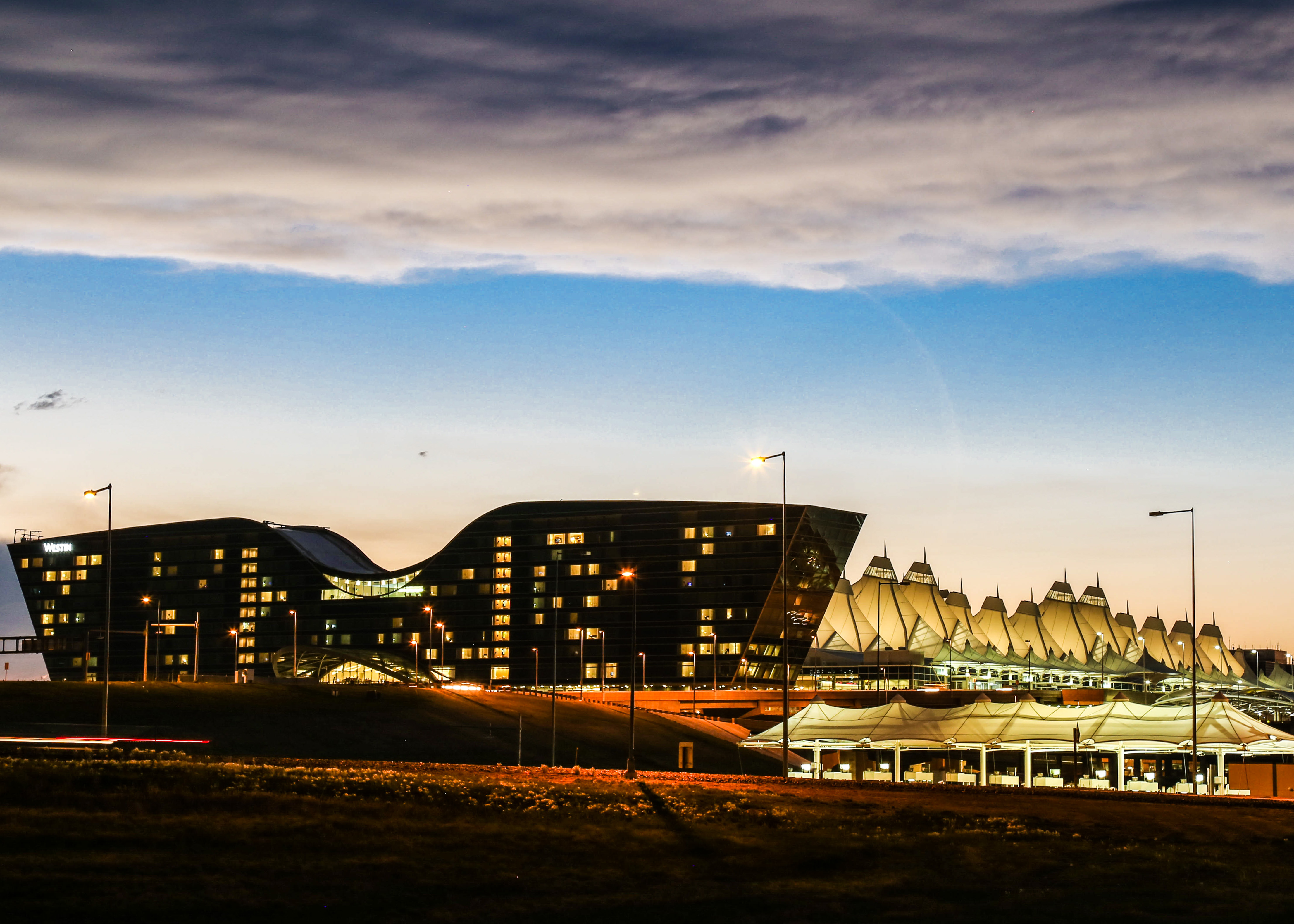
Where: Montbello, Parkfield, Gateway-Green Valley Ranch, High Point, DIA (see district map here)
Defining Aspects of the District: Most of District 11 contains the land surrounding Denver Airport, from the Peña Boulevard exit on I-70, which means that the airport and its priorities are often at the forefront. However, Montbello is one of Denver’s largest neighborhoods and houses over 30,000 residents, so District 11 is certainly not singularly for the airport.
District Issues: Because of the inclusion of the airport, District 11 is often undervalued and the diverse residents tend to be forgotten. Some of their main concerns have to do with lack of mobility, lack of community resources like grocery stores and the mundanity of the suburban sprawl. Montbello was historically separated from the rest of Denver by Stapleton Airport, which is now redeveloping, so many community members are looking at ways to improve connectivity with the rest of the city.
Who’s running
Incumbent: Stacie Gilmore. Read our profile on her here.
For: Beautification of parks and green space, workforce investments (she secured over $500,000 toward these during her last term), affordable housing, public-private partnerships and transportation and infrastructure improvements.
Against: Discrimination in housing, rising retail costs that affect small businesses, lack of access to livable wage jobs and food deserts.
For: Fighting to protect the environment, representing the Latinx community (some of her videos on her campaign website are spoken in Spanish), pushing for family services, improving education resources for the youth and maintaining a minimum wage above $15 per hour.
Against: Pollution and environmental degradation, high cost of existing public transportation and lack of overall public transportation, non-livable wages, skyrocketing house prices.







